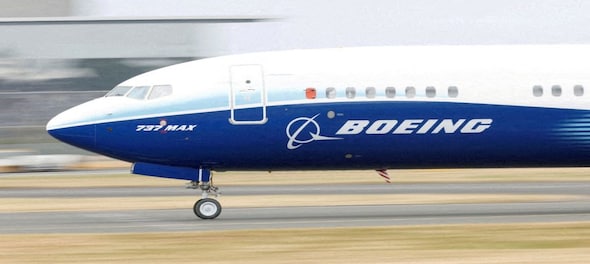
US aviation regulators ordered Boeing Co. to halt further production-rate increases for its 737 Max aircraft even as they cleared the way for a version of the jet involved in a near-calamity to return to the skies.
The US Federal Aviation Administration said it informed Boeing that the agency wouldn’t allow any further output increases, according to a statement late Wednesday. At the same time, it approved the inspection procedures that airlines must carry out in order for the 737 Max to resume flights after they were grounded by the agency earlier this month.
The FAA action leaves Boeing unable to boost output of its cash-cow jetliners for the foreseeable future, at a time when airlines are clamoring for new planes to meet soaring demand for air travel. It comes days before Boeing Chief Executive Officer Dave Calhoun is due to set annual targets for Boeing’s 737 deliveries, a measure closely watched by investors, with its January 31 earnings.
The company had been working to stabilize output of the 737 at a pace of 38 jets a month prior to the Alaska Airlines accident, when a door plug blew off mid-flight, while signaling to suppliers that it would start to speed up production later in the first quarter.
The FAA is also halting work on Boeing’s planned new 737 final assembly line at its widebody plant in Everett, about an hour’s drive north of its current narrow-body manufacturing hub.
“This won’t be back to business as usual for Boeing,” FAA Administrator Mike Whitaker said in the statement. “We will not agree to any request from Boeing for an expansion in production or approve additional production lines for the 737 Max until we are satisfied that the quality control issues uncovered during this process are resolved.”
The decision escalates the mushrooming crisis that’s taken hold at the aerospace behemoth since the panel blew off a nearly new Max 9 operated by Alaska Airlines shortly after takeoff on January 5.
Although no passengers or crew were seriously injured, the accident and revelations of loose hardware found on other grounded Max 9 jets has put Boeing under intense scrutiny by the agency, customers and the flying public.
Boeing has been aiming to return production of the 737, the company’s main source of revenue and profit, to pre-Covid levels by mid-decade. The production increases are needed to boost income that would help pay down Boeing’s debt load.
To help push monthly output of the single-aisle aircraft to even higher rates, Boeing has been installing a fourth final assembly line in its Everett factory, where it traditionally built widebody jets such as the 747. The new line would be the first to manufacture the the workhorse 737 outside of the Renton factory.
A Boeing spokeswoman didn’t immediately respond to a request for comment.
At the same time, Max 9 operators United Airlines Holdings Inc. and Alaska Air Group Inc. can finally resume flights on those planes once they’ve been inspected. The planes had been grounded since January 6.
Alaska Airlines plans to return its first Max 9 to flights on January 26, with inspections on the full fleet of 65 completed by February 2, the carrier said in a statement Wednesday. The inspections take about 12 hours per plane, possibly longer, it said.
United will resume Max 9 flights starting January 28.
“The exhaustive, enhanced review our team completed after several weeks of information gathering gives me and the FAA confidence to proceed to the inspection and maintenance phase,” the FAA’s Whitaker said in the statement.
Check out our in-depth Market Coverage, Business News & get real-time Stock Market Updates on CNBC-TV18. Also, Watch our channels CNBC-TV18, CNBC Awaaz and CNBC Bajar Live on-the-go!


Punjab Lok Sabha elections: Complete list of Congress candidates
May 18, 2024 4:08 PM
Punjab Lok Sabha elections: Check full list of AAP candidates and constituencies
May 18, 2024 12:59 PM
PM Modi, Rahul Gandhi election rallies in Delhi today: Here are the routes to avoid
May 18, 2024 11:28 AM

